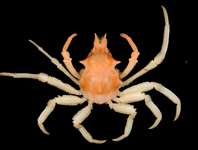Abstract
Cornigerius species are endemic to the Ponto-Caspian, with the exception of Cornigerius lacustris, which is endemic to freshwater Lake Hazar in the Euphrates basin. However, the barcoding fragment of the cytochrome c subunit I (COI) of animals from the type locality shows less than 1 % divergence with Black Sea and less than 2% with Caspian Lake C. maeoticus, the oldest and most widespread species of the genus. Black Sea and Caspian Lake animals show 1.5 % divergence. We therefore place the origin of the Hazar population in the Black Sea. Combined with a variable morphology, we also conclude that C. lacustris is a synonym of C. maeoticus, as already suspected by its describer. Dating the ‘lacustris’ population is difficult, but it has been there for at least a century.
References
Aksoy E., Inceoz, M. & Koçyiğit, A. (2007) Lake Hazar Basin: a negative flower structure on the East Anatolian fault system (EAFS), SE Turkey. Turkish Journal of Earth Sciences, 16, 319–338.
Çoban M.Z., Gündüz, F., Demirol, F., Örnekçi, G., Karakaya, N., Türkgülü G. & Alp, A. (2013) Population dynamics and stock assessment of Capoeta umbla (Haeckel, 1843) in Lake Hazar, Elazið, Turkey. Turkish Journal of Fisheries and Aquatic Sciences, 13, 221–231.
https://doi.org/10.4194/1303-2712-v13_2_04
Cristescu, M.E.A., Hebert, P.D.N. & Onciu, T.M. (2003) Phylogeography of Ponto-Caspian crustaceans: a benthic-planktonic comparison. Molecular Ecology, 12, 985–996.
https://doi.org/10.1046/j.1365-294X.2003.01801.x
Dumont, H.J. (1994) Ancient lakes have simplified pelagic food webs. Archiv fur Hydrobiologie, Beihefte Ergebnisse der Limnologie, 44, 223–234.
Dumont, H.J. (1998) The Caspian Lake: history, biota, structure and function. Limnology and Oceanography, 43, 44–52.
https://doi.org/10.4319/lo.1998.43.1.0044
Dumont, H.J., Vierstraete, A. & Vanfleteren, J.R. (2007) A revised molecular phylogeny of the Calopteryginae (Zygoptera: Calopterygidae). Odonatologica, 36, 365–372.
Folmer, O., Black, M., Hoeh, W., Lutz, R. & Vrijenhoek, R. (1994) DNA Primers for amplification of mitochondrial cytochrome c oxidase subunit I from diverse metazoan invertebrates. Molecular marine biology and biotechnology, 3, 294–299.
Ivanov, V.P., Kamakin, A.M., Ushivtsev, V.B., Shiganova, T., Zhukova, O., Aladin, N., Wilson, S.I., Harbison, G.R. & Dumont, H.J. (2000) Invasion of the Caspian Sea by the comb jellyfish Mnemiopsis leidyi (Ctenophora). Biological Invasions, 2, 255–258.
https://doi.org/10.1023/A:1010098624728
Katoh, K., Rozewicki, J. & Yamada, K.D. (2017) MAFFT online service: multiple sequence alignment, interactive sequence choice and visualization. Briefings in Bioinformatics. [published online]
https://doi.org/10.1093/bib/bbx108
Kosarev, A.N. & Yablonskaya, E.A. (1994) The Caspian Sea. SPB Academic, The Hague, 259 pp.
Kumar, S., Nei, M., Dudley, J. & Tamura, K. (2008) MEGA: A biologist-centric software for evolutionary analysis of DNA and protein sequences. Briefings in Bioinformatics, 9 (4), 299–306.
https://doi.org/10.1093/bib/bbn017
Leigh, J.W. & Bryant, D. (2015) PopART: full-feature software for haplotype network construction. Methods in Ecology and Evolution, 6, 1110–1116.
https://doi.org/10.1111/2041-210X.12410
Mordukhai-Boltovskoi, P.D. (1967) On the taxonomy of the genus Cornigerius. Crustaceana, 12, 113–123.
https://doi.org/10.1163/156854067X00521
Panov, V., Rodionova, N.V., Bolshagin, P.V. & Bychek, E.A. (2007) Invasion biology of ponto-caspian onychopod cladocerans. Hydrobiologia, 590, 3–14.
https://doi.org/10.1007/s10750-007-0752-0
Pengo, N. (1879) On a new crustacean from the family Polyphemidae. Trudy Obshchestva ispytatelei prirody pri Imp. Kharkovskom Universitiete, 13, 1–10. [in Russian]
Ryan, W.B.F., Pitman W.C., Major, C.O., Shimkus, K., Moskalenko, V., Jones, G.A., Dimitrov P., Gorür, N & Sakinç M. (1997) An abrupt drowning of the Black Sea shelf. Marine geology, 138, 119–126.
https://doi.org/10.1016/S0025-3227(97)00007-8
Rivier, I.K. (1998) The predatory Cladocera (Onychopoda: Podonidae, Polyphemidae, Cercopagidae) and Leptodorida of the world. Guides to the Identification of the microinvertebrates of the continental waters of the world 13. Backhuys, Leiden, 213 pp. [with introduction by H. J. Dumont: The Caspian Craddle (sic)]
Spandl, H. (1923) Neue Entomostraken und Dinoflagellaten. Annalen Naturhistorisches Museum, Wien, 36, 3–4.
Saler, S. & Arslan, S. (2007) TMÝ12 Göleti (Elazyğ) Copepoda ve Cladocera (Crustacea) Faunasý. E.U. Journal of Fisheries & Aquatic Sciences, 24 (1–2), 191–193
Tellioğlu, A. ve D. Şen (2001) Seasonal Variation of Copepoda and Cladocera fauna of Hazar Lake (Elazýğ). G. Ü. Gazi Eðitim Fakültesi Dergisi, 21 (2), 7–18.
Tokat, M. (1972) Copepoda and Cladocera of Lake Hazar (Gölcük). Vol. 10. Publications of the hydrobiological Research Institute, Faculty of Sciences, University of Istanbul, Istanbul, 19 pp. [in Turkish]
Xu, L., Han, B.P., Van Damme, K., Vierstraete, A., Vanfleteren, J.R. & Dumont, H.J. (2011) Biogeography and evolution of the Holarctic zooplankton genus Leptodora (Crustacea: Branchiopoda: Haplopoda). Journal of Biogeography, 38, 359–370.
https://doi.org/10.1111/j.1365-2699.2010.02409.x
Zernov, S.A. (1901) Results of zoological excursion on the Sea of Azov on board ship “Ledokol Donskikh Girl” from May 10 to 20, 1900. Ezhegodnik zoologicjeskogo muzeya, St. Petersburg, 6 (4), 559–584.

